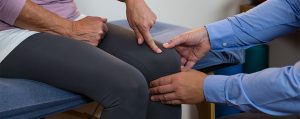Limited Hip Mobility and Core Weakness: Causes of Lower Back Pain in Golfers
Posted on by Athletico
With the golf season now in full swing, many golfers may be experiencing some aches and pains from the first several rounds of the course. Low back pain is a specifically common aliment among golfers. Low back pain can be caused by numerous factors, but two areas of deficit are common culprits to low back pain among golfers. (more…)
Stretch of the Week: Final Psoas Stretch
Posted on by Athletico
The final week of May is here! How are you doing? How is your back? Make sure you check in with yourself, it helps to create body awareness as you stretch. For the last week of May you will have three options for a psoas stretch. I will be giving beginner, intermediate, and advanced variations for this psoas stretch. If you have a history of low back problems stick with the beginner variation. (more…)
What is Arthritis and What Can I Do About It?
Posted on by Athletico
May is National Arthritis Awareness Month. But what exactly is arthritis? What causes the pain and how can I fix it? Arthritis refers to the degradation of a joint surface causing inflammation within the joint. Athletico Physical Therapy is proud to support Arthritis Awareness Month as a proud partner of the Arthritis Foundation. (more…)
Stretch of the Week: High Lunge with Psoas Emphasis
Posted on by Athletico
Week 3 of May might look a little familiar to you if you've been with the stretch of the week blog from the beginning. It's called High Lunge. In this variation we are focusing on getting a deeper stretch through the psoas though. So it's different I promise! :)
You will need two yoga blocks or something similar, and a wall for this stretch. (more…)
High Heels: Great for Fashion, Bad for Your Body
Posted on by Athletico
Every lady loves the way her legs look in a killer pair of high heels. But what most women don’t know is that habitual use of those great shoes can have severe effects on joint health. High heels change foot posture, which then in turn changes the alignment of the entire lower body and the direction of the pull of gravity in relationship to those joints, thus stresses muscles in an abnormal fashion. (more…)
Stretch of the Week: Upward Facing Dog
Posted on by Athletico
Week two of May is a bit of a deeper psoas stretch. It doesn't have a name but I guess we can call it a variation on the yoga pose upward facing dog. In this variation we are focusing on the front of the hip where the psoas resides. (more…)
What is Work Comp?
Posted on by Athletico
A common question I receive in my travels as an Work Comp therapist is “What is Work Comp and who needs it?” Essentially Work Comp is an extension of physical and occupational therapy services for injuries that occurred while in a work setting or environment. (more…)
Stretch of the Week: Psoas Opener
Posted on by Athletico
During the month of May we will be focusing on a crucial muscle involved in low back pain, our psoas muscle. Back in December we addressed our quads and hip flexors (please feel free to check back through our Stretch of the Week archive for those stretches!), which did get into the psoas a little, but this month we will try to isolate it. For the first week we will start with a gentle psoas opener, it's a variation of what's called a Bridge in the exercise world. (more…)
